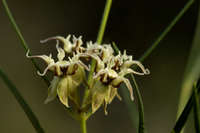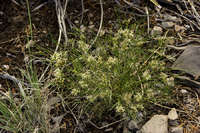|
|
|
|
Family: Apocynaceae
longhood milkweed
|
Plant: suffrutescent perennial; 15-35 cm tall; stems numerous, ascending, slender, copiously branched, finely short pubescent in lines above the leaves; milky sap Leaves: opposite, sessile, the blades narrowly linear, 2-9 cm long, 0.5-1.5 mm broad, glabrous, the margins revolute INFLORESCENCE: UMBELS lateral at 1 to few of the upper nodes, ca. 2 cm broad, the peduncles 0.1-0.7 cm long Flowers: small; calyx lobes ca. 2 mm long; corolla green to purple-tipped outside, greenish inside, the lobes 4-5 mm long; hoods purple below, yellowish white on the sides, undulate and ciliate along the upper margin, broadly rounded at the base, erect-ascending and oblong in the lower portion, recurved-spreading near the middle to an attenuate apex, 4-5 mm long along the dorsal surface, the margins ca. 2 mm high and about as long as the gynostegium, the horns radially flat, attached near the base of the hoods, erect, exserted ca. 1 mm; anther wings 1-1.1 mm long; corpusculum 0.3 mm long, the pollinia 0.6-0.7 mm long Fruit: FOLLICLES erect on deflexed pedicels, 4-8 cm long Misc: Grasslands and open woodlands, mts; 1400-2050 m (4600-6800 ft); Jun-Aug REFERENCES: Sundell, Eric. 1994. Asclepiadaceae. J. Ariz. - Nev. Acad. Sci. Volume 27, 169-187. Sundell 1993, Woodson 1954, Kearney and Peebles 1969 Duration: Perennial Nativity: Native Lifeform: Subshrub General: Low, suffrutescent perennials, 15-35 cm tall; stems numerous, ascending, slender, copiously branched, finely short-pubescent in the lines above the leaves, very slender and twiggy. Leaves: Opposite and sessile; blades narrowly linear, 2-9 cm long, 1 mm broad, glabrous, the margins revolute. Flowers: Small, yellow-green and brown-purple, in 2 cm umbels, those lateral in upper nodes, on peduncles 0.5 cm long; corolla green to purple-tipped outside, greenish inside, lobes 4-5 mm long; hoods purple below, yellowish white on the sides, undulate and ciliate along the upper margin, broadly rounded at the base, erect-ascending and oblong in the lower portion, recurved-spreading near the middle to an attenuate apex, 4-5 mm long along the dorsal surface, margins 2 mm high; horns radially flat, attached near the base; calyx lobes about 2 mm long. Fruits: Follicles erect on deflexed pedicels, 4-8 cm long. Ecology: Found in grasslands and in open woodlands from 4,500-7,000 ft (1372-2134 m); flowers May-October. Distribution: w OK, w TX, s CO, NM, se AZ, south into Coahuila, n MEX. Notes: A decumbent to ascending habit, dense, bushy growth, and opposite, sessile, linear leaves with revolute margins help to distinguish this species from other milkweeds. Ethnobotany: Unknown, but other species in this genus have uses. Etymology: Asclepias is named for the Greek god of healing Asklepios, while macrotis comes from the Greek makros or large, and the Greek ous, for ear. Synonyms: None Editor: SBuckley 2010, 2014, FSCoburn 2015, AHazelton 2015 |




